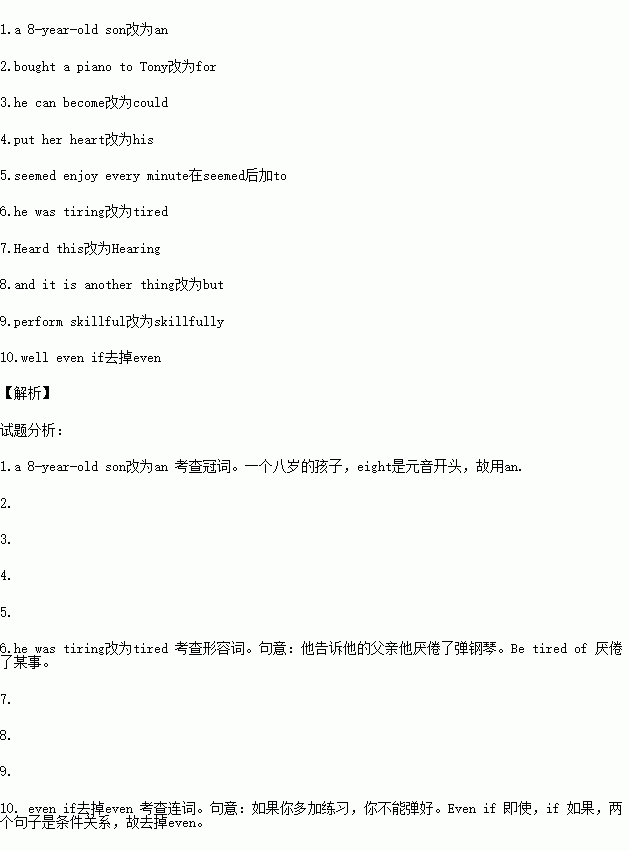题目内容
短文改错:
假如英语课上老师要求同学们交换修改作文,请你修改你同桌写的以下作文。文中共有10处语言错误,要求你在错误的地方增加、删除或修改某个单词。
增加:在缺词处加一个漏字符号(∧),并在其下面写上该加的词。
删除:把多余的词用斜线(﹨)划掉。
修改:在错的词下划一横线,并在该词下面写上修改后的词。
注意:1. 每处错误及其修改均仅限一词;2. 只允许修改10处, 多者(从第11处起)不计分。
Mr. Smith had a 8-year-old son named Tony, who enjoyed listening to music very much. So he bought a piano to Tony, hoping that he can become a famous pianist one day. The little boy put her heart into practising the piano day after day and seemed enjoy every minute of it. However, half a year later, he told his father that he was tiring of practising the piano. Heard this, Mr. Smith said, “Tony, it is one thing to be fond of listen to music, and it is another thing to perform skillful by yourself. You can never play the piano well even if you don’t practise more.”
任务型阅读
请认真阅读下列短文,并根据所读内容在文章后表格中的空格里填入一个最恰当的单词。
注意:请将答案写在答题卡上相应题号的横线上。每个空格只填1个单词。
Have you ever been so absorbed in a conversation at a party that you failed to notice that someone new is standing only six inches away from you, trying to get your attention? It’s possible that you were so distracted that you didn’t notice someone approaching you. But it’s also entirely likely that you were experiencing change blindness.
Change blindness is a phenomenon that occurs when a person is unable to notice visual changes in their environment, despite the fact that they are often rather obvious. In cases of change blindness, the person isn’t failing to notice small or insignificant changes, but will probably miss big changes, like someone standing next to them waving their hand.
Early experiments with change blindness focused largely on memory and perception when viewing pictures. For example, a person might be shown a photograph of a street scene in Egypt and told to memorize the image. Following that, they would be shown the same picture with certain elements added or taken away and asked to identify what’s different. Very often the individual could recall the larger aspects of the picture but couldn’t recognize the smaller changes.
In the 1990s, researcher Daniel Simons conducted a fascinating study into change blindness that many people find unbelievable. In Simons’ study, he asked participants to watch a video of a basketball being passed around between several people, with a particular focus on the basketball itself. When the experiment was over, Simons found that a large number of participants were so focused on watching the basketball being passed around that they failed to notice a man in a gorilla suit jumping around in front of the camera.
It’s important to note that the change in Simons’ video wasn’t subtle; the gorilla is very obviously taking up much of the frame. Simons concluded that participants were experiencing inattentional blindness, which is when a person fails to notice a major change because they are so focused on another task. In this case, because participants were asked to focus on the movement of the basketball, their brains prioritized that task in order to do it properly, thereby missing the other things happening in the video.
In the case of Simons’ study, participants engaged what’s referred to as attentional selection, which is when a person selects certain things to focus on in order to achieve a task and filters out anything that is unrelated to the objective.
There are a number of theories about what causes a person’s inability to recognize obvious changes in their environment, but most agree that the phenomenon is related to sensory processing. Broadly speaking, our brains have a limited capacity to detect and process everything in our environment. Instead, what the brain does is to choose certain things to process, evaluate, and store, which allows other things to be missed or filtered out.
In simple terms, change blindness has a great deal to do with where a person directs their attention. In the case of the gorilla and the basketball, people focused their attention almost exclusively on one thing, which caused them to miss other elements or changes. Given that attention is often at the root of change blindness, a person’s age or mental and physical health can influence how well they will notice changes in stimuli.
Change Blindness | |
1. of change blindness | Change blindness is a surprising perceptual phenomenon that occurs when a person recognizes minor changes in scenes while large changes go 2. . |
Experiments with change blindness | ●The main 3. of early experiments was memory and perception. ●Individuals were found to be4. at recalling the smaller details in the same picture previously shown to them. |
Research in the 1990s | ●In Simons’ study, participants were asked to pay special attention to the 5. basketball, during which time a man wearing a gorilla suit unexpectedly walked through the scene. ●Contrary to popular belief, with their attention fixed on the basketball, many participants reported that the “gorilla” 6. their notice. ●It is concluded that participants fail to recognize something big but unrelated to the objective when their brains are programmed to consider some task as a top 7. . |
8. of change blindness | ●The brain makes 9. about what to be dealt with because of its limited capacity. ●Although attention is closely10. to change blindness, age and health are other factors that play a role. |

